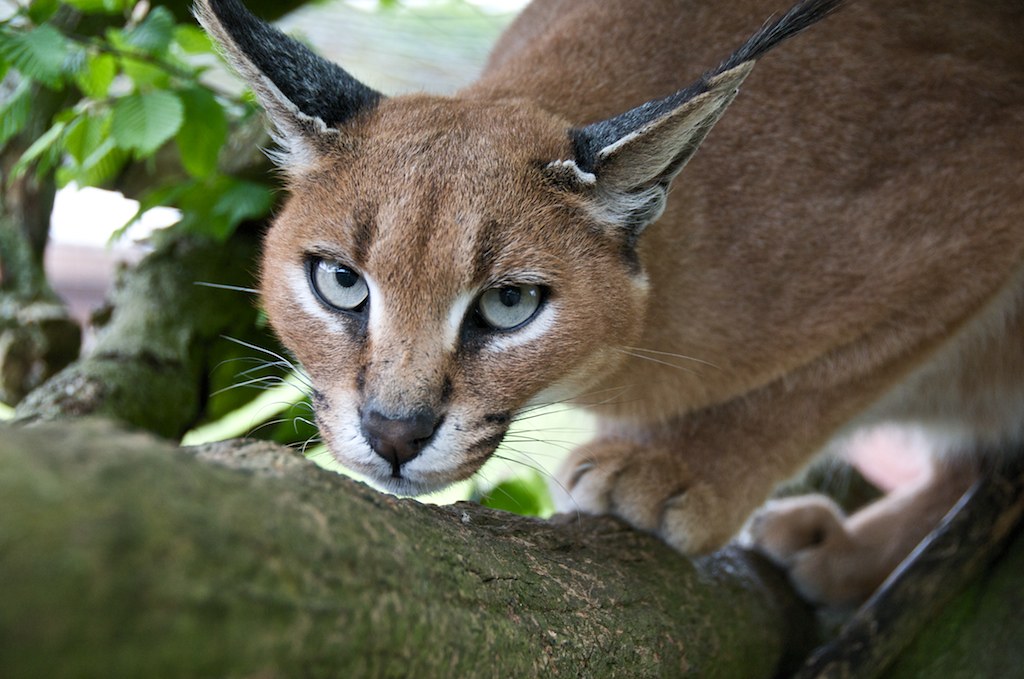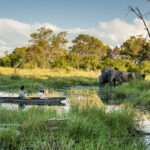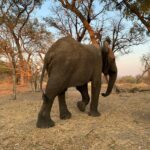Seeing big cats on safari is the dream! After all, who wouldn’t want to sit beside a lion, watch a leopard hunt, or stand in awe of a cheetah’s run? But did you know that there are more cats in Botswana than you might think?
As the next submission in our Brave Africa blog series Animals of Botswana, we’re tackling all of Botswana’s cats—big and small. Get to know all the different types of cats you could enjoy and why we love them. You could see many of these on your next game drive with us!
Lion
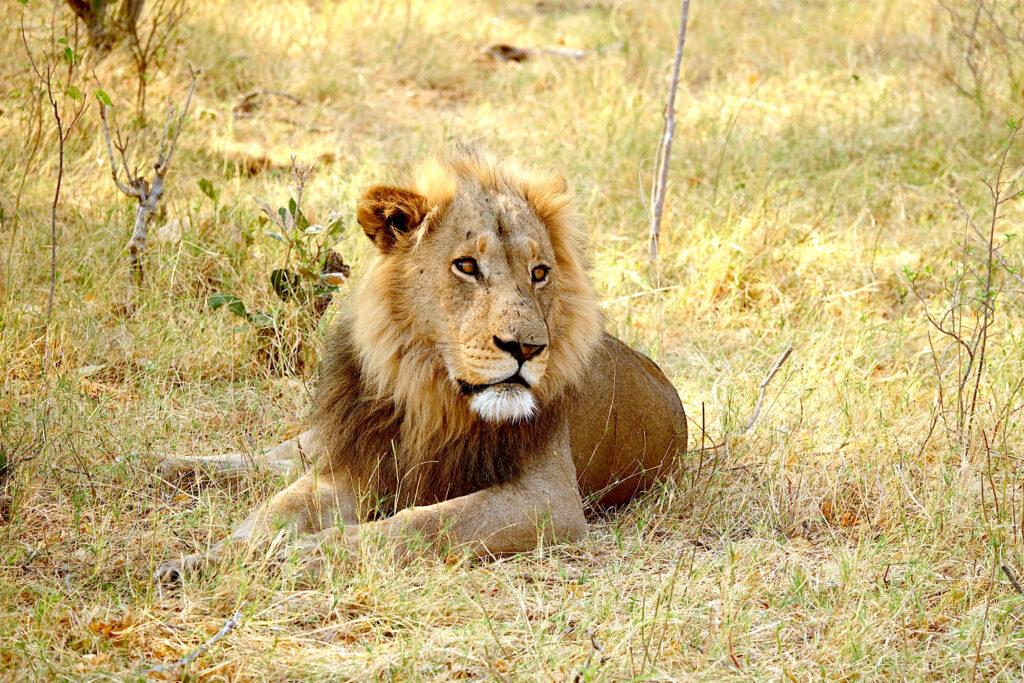
The largest lion on record weighed 375 kg (826 lbs).
Lions are the kings of the African bush. As an apex predator, they roam the open savannahs and grasslands of Botswana, looking for prey. They are the second-largest cat in the world, known for their strength, ferocity, and laziness. J Unfortunately, they are also becoming rarer and rarer in the wild. There are only about 20,000 African lions left, and they are listed as “Vulnerable” on the endangered species list. In Botswana, these cats are fairly prevalent with the second-largest population in all of Africa.
How to recognize lions:
Lions are easy to identify because they are massive, weighing up to 180kg (400 lbs)! Here are a few more characteristics:
- Lions have yellow-gold fur that’s generally short. Adult males typically boast a mane of long, brownish hair encircling their heads.
- Lions roar to declare territory, ward of rivals, call for backup, and communicate with their pride. Their roar can be heard up to 8km away.
- Lions are well-muscled cats with long bodies, large heads, and short legs.
Where can you find lions?
Lions can be found all across Botswana’s wilderness from the arid desert of the Kalahari to the swamplands of Moremi and the grasslands of Savuti. You’ll find lions both as solitary individuals as well as in prides of up to 40 lions. While lions can live and hunt in almost any habitat, they prefer grasslands, shrubs, and open woodlands.
Leopard
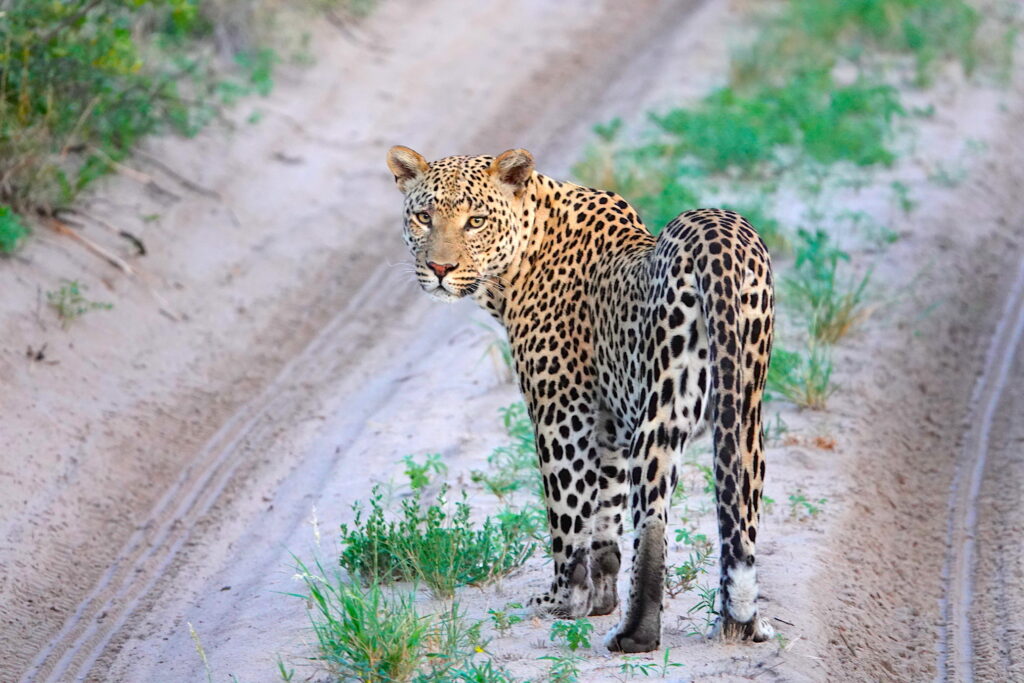
Leopards are highly skilled climbers that use trees to keep prey from scavengers.
Leopards are some of the most elusive cats in all of Africa. They are nocturnal predators known for their exceptional night vision and climbing abilities. They are graceful hunters that are also incredibly adaptable. They aren’t just found in Africa. You can find leopards all over the world in a diverse array of climates, from jungles to forests and deserts across India, China, Central Asia, and Africa.
How to recognize leopards:
Arguably, leopards are one of the most beautiful cats in Botswana and all of Africa, but they are very secretive. That’s why it’s essential to know how to recognize them.
- Leopards are known for their light yellow fur covered in distinctive spots known as rosettes. These irregular dark spots are circular or square in shape and sort of look like roses.
- Leopards are medium-sized cats weighing between 24 to 53 kg (53 – 115 lbs) and are extremely muscular.
- Leopards make a very distinctive hoarse, raspy cough sound to communicate with their young and mark their territory. They can also hiss when threatened.
Bonus: Some leopards can be completely black, although this is a rare coat color that’s the opposite of albinism.
Where can you find leopards?
Botswana leopards enjoy a wide range of habitats from dense bush to forests. They enjoy both hot and cold climates, including semi-desert regions. You can find leopards on the ground as often as they are in the trees, although if they’ve made a recent kill, their dinner will almost always be in a tree to keep it out of reach of scavengers.
The most common of Botswana’s cats, leopards can be found all over, but your best chances are in the Moremi Game Reserve. However, it’s important to note that a high concentration of lion means it is less likely you’ll see a leopard, as it is too dangerous for them to hunt.
Cheetah
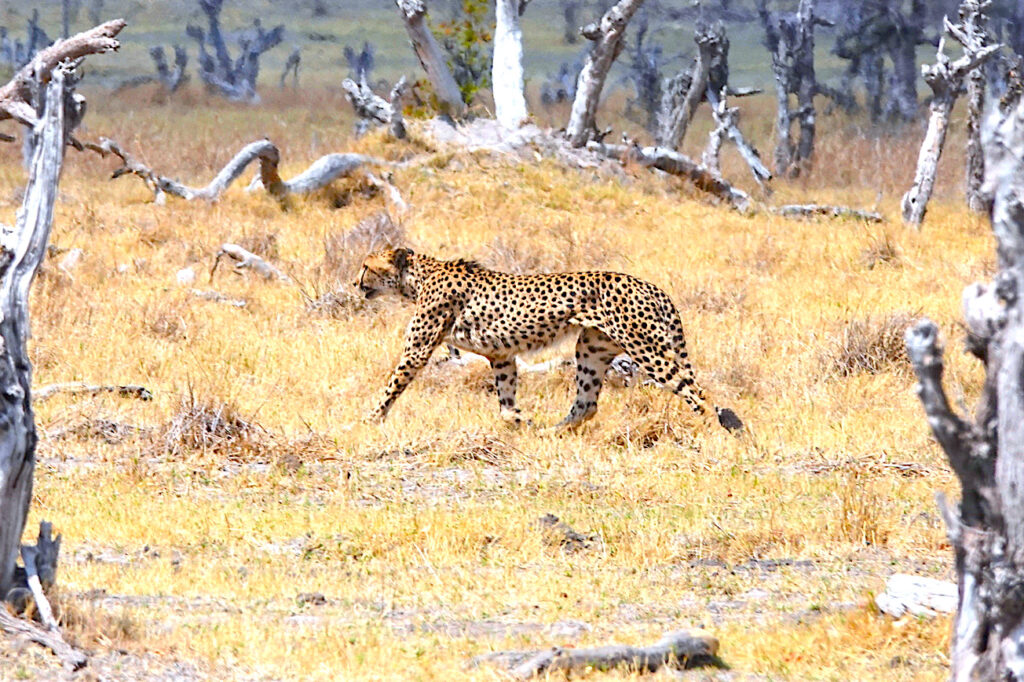
Cheetahs can accelerate faster than a sports car, reaching up to 112 km/hr in three seconds.
Cheetahs are some of the smallest of the big cats in Botswana, but they are also the fastest. They can go from 0 to 96 kilometers an hour (60 mph) in just three seconds. Even at these high speeds, cheetahs are very agile and can make sudden turns to catch their prey. They have exceptionally keen eyesight, which makes them one of the few big cats that prefer to hunt in the daylight.
How to recognize cheetahs:
As the fastest land mammal, cheetahs can be hard to come by. They are solitary by nature and highly timid, which means you have to be very lucky to see one.
- Cheetahs are smaller cats weighing between 34 and 57 kg (75 – 125 lbs). They have a thin frame, a narrow waist, and a deep chest, giving them the appearance of a long, very slender body.
- Golden in color, cheetahs have solid black spots and very distinctive black facial strips running from their eyes, which almost look like tears.
- Cheetahs are very vocal. They purr when content, and growl, hiss, spit, moan, and yowl in danger, annoyance, or to threaten other predators. One of their most distinctive sounds is the chirp, which they use when excited. It can be heard up to 2km away.
Where can you find cheetahs?
Cheetahs are nomads by nature, which means they never stay in one place for long and can cover vast distances in search of prey. They can most often be found in wide-open grasslands where it’s easier to run after prey as needed. However, because it takes a large amount of energy to catch and kill their prey, they prefer to hang out in the shade to preserve what energy they can.
Botswana is home to 25% of the world’s remaining cheetah population and is the ONLY country where the population remains stable. They can be found throughout the Okavango Delta in any area where there are open plains. Savuti typically offers your best chance.
Serval
Beyond the big cats, there are also medium-sized wild cats, such as the serval. These seldom-seen predators prey on mice, rats, and other small animals, including young antelope. They use their big ears to locate prey by sound and then use their legs to run through tall grass and pounce. They are a swift and agile Botswana cat that leaps very well and hunts mostly at night.
How to recognize servals:
Servals might be common throughout Africa, but because they prefer to live and hunt in bush, tall grass, and in dry reed beds, they are hard to spot. That means it’s essential to know what they look and sound like.
- Servals are medium-sized, slender cats, weighing between 9 – 18 kg (20-40 lbs). They have small heads, large ears, and the longest legs of any cat relative to their body size.
- They are characterized by having golden coats spotted and striped in black, including a short, black-striped tail.
- Servals are solitary cats that are incredibly territorial. That’s why you’ll hear chirps, purrs, hisses, snarls, and growls.
Where can you find servals?
Servals are active in both the daytime and at night, meaning you can see them at almost anytime. On top of that, they are listed as one of the animals of “Least Concern,” according to the IUCN Red List. However, that does not mean you’ll see a serval. Because they are smaller, they are more difficult to find, especially considering they prefer wetter areas with long grass.
You’ll have your best chance of encountering a serval in northern Botswana. They can be found in Khwai and throughout the Okavango Delta as well as in the Linyanti, Kwando, and Savuti areas. Most often, good sightings occur during night drives.
Caracal
Another rare, medium-sized cat that you might run into is the caracal. This highly secretive cat is difficult to observe, particularly since they live alone or in pairs and are active mostly at night. They are excellent leapers that can catch birds in midair, but also hunt rodents and small antelope. Remarkable hunters for their size, caracals are characterized by their ability to get within a meter of prey before pouncing.
How to recognize caracals:
Caracals are sleek cats built for sneak attacks. And they are super fast and almost silent, so seeing one in the wild is a very rare opportunity. Here’s how to recognize a caracal.
- Caracals have a robust build with long legs, short faces, and long-tufted ears. They weigh between 8 – 18 kg (18 – 40 lbs).
- Their coat is uniformly reddish tan or sandy with some lighter sections on their stomach, neck, and jaw.
- Like many smaller wild cats, they make a variety of sounds, including purrs, mews, growls, and hisses. However, these guys are mostly silent except for a “wah-wah” sound that they make when uneasy.
Where can you find caracals?
You can find caracals throughout sub-Saharan Africa. They have adapted to a wide variety of environments, which is why they are of “Least Concern” when it comes to endangered species. They mostly prefer to live in dry areas with low rainfall and lots of cover. That’s why you’re more likely to find them in savannas, marshy lowlands, semi-deserts, and scrub forests.
Your best chance of seeing a caracal—one of Botswana’s cats—is during a night drive or in the early evening. Areas such as the Kalahari and Savuti would provide the best chance of a sighting, but it is very rare.
https://www.youtube.com/watch?v=V4e6PsA6mmI
African Wildcat

African Wildcat image courtesy of Martin Heigan (Flickr).
Found across the African continent, the African wildcat is also known as a “bush cat.” About 10,000 years ago, some African wildcats were domesticated, which is why they are considered the ancestors of the domestic cat and have many similar features. The smallest of the cats, they primarily eat mice, rats, and other small mammals, though they will also eat birds, reptiles, and insects. Most active during the night and twilight, you’ll rarely see an African wildcat on safari.
How to recognize African wildcats:
During the daytime, African wildcats tend to hide in bushes and wait until dark to hunt. And since they are also solitary, these prolific hunters are hard to spot.
- The body of an African wildcat is similar to a domesticated cat except for their long legs. Size-wise, they weigh between 2.4 – 5.5 kg (5 – 12 lbs).
- African wildcats typically have sandy brown or yellow-gray coats with black stripes on their tails. Their chins and throats are often white with rich, reddish-brown coloring on the back of their ears, belly, and on the back of their legs.
- Look for two dark rings on their forelegs and stripes on their hind legs. Their tails also tend to have two to three rings toward the end with a black tip.
Where can you find African wildcats?
The African wildcat inhabits a wide range of landscapes, but they especially enjoy hilly and mountainous regions. However, they can also be found in deserts as well as in tropical areas, grasslands, scrublands, and more. You’ll have your best chance of seeing an African wildcat on a cloudy day or after dark, during a night drive. They are well adapted to surviving in almost any region.
Black-Footed Cat
The smallest species of wild cats, the black-footed cat is very similar to a domestic cat. However, they are considered the deadliest cat in all of Africa. They respond to the tiniest sounds and have superb night vision, making them incredible hunters. They’ll eat almost anything that moves, including insects, birds, and other small mammals. Exceptional hunters, they stalk their prey in complete silence and then pounce when the time is right.
How to recognize black-footed cats:
Black-footed cats are adorable and look very much like a cuddly domestic cat. They are incredibly rare to see, with no recent records in Botswana.
- Black-footed cats are stocky and compact, weighing between 1.3 – 1.9 kg (2.9 – 4.2 lbs).
- They are recognizable due to their rounded ears, large eyes, and short black-tipped tails.
- Their fur is used as camouflage and is varied in color. However, it’s most often between cinnamon and tawny with patterns of black or brown spots forming rings on the legs, neck, and tail.
Where can you find black-footed cats?
Black-footed cats are found in drier areas of Southern Africa. They prefer deserts of semi-arid regions where there is hot sand and mostly tall grasses and scrubs. As one of Botswana’s cats, this means areas of the Kalahari, Nxai Pan, and Makgadikgadi are their preferred hunting grounds. However, since they are nocturnal, seeing a black-footed cat is incredibly rare, not the least of which is because they are considered “Vulnerable” according to the IUCN Red List of Threatened Animals.
So Many Amazing Botswana Cats
There are so many amazing Botswana cats to see during a safari. To see them all, you’ll have to keep your eyes peeled and have some amazing luck—especially for the smaller species. For lions, leopards, and cheetahs, Botswana is a lush hunting ground. Guests have strong possibilities of discovering a pride of lions or witnessing a lone leopard walking along the road, but with everything in the wild, nothing is guaranteed.
Check back on our blog and our social media regularly to learn more about our recent sightings. And don’t forget to check out our previous Animals of Botswana blogs, including Botswana Antelopes and Africa’s Big 5.



